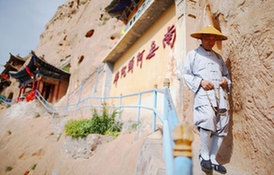Taking a bite of the Silk Road
Exotic delicacies like Persian bread, Indian desserts and Arabic naan, among other foods, abounded on the Silk Road, as evidenced by the frescoes in the Mogao Caves at Dunhuang, Gansu province.
Related: Experts investigate Silk Road's ancestors
Grottoes along the ancient Silk Road are home to roughly 70,000 square meters of frescoes. These murals and about 50,000 ancient books that have been unearthed in the same areas offer vivid accounts of what adventurers ate on the grand trade route that linked the Chinese city of Xi'an with Rome from about 110 BC to the late 1400s.
"Many paintings portray people eating doner kebab, a food that has swept the world nowadays," said Gao Qi'an, a Dunhuang researcher at Lanzhou University of Finance and Economics.
 |
| Gansu's great Silk Road secrets |
Researchers also found some of the cookware used to make these dishes, and they are as same as the pans and griddles still used by people living in Gansu's rural Hexi Corridor.
Zhao Chang'an, deputy chairman of the Gansu Institute of Dunhuang Studies, is breathing new life into these ancient delicacies.
Dunhuang was a trading hub on the ancient Silk Road. Given its close proximity to Central Asia, dozens of ancient nationalities could be found there -- and where people mix, so do cuisines.
Zhao's restaurant has developed over 400 dishes reminiscent of the foods that dotted the ancient Silk Road. Tourists can have a taste of the Silk Road for about 100 yuan (16.3 US dollars) per head.
"It's not just about the food. How people eat also matters," Zhao said. "The dignitaries cared a lot about etiquette. They even asked waiters and waitresses to serve food with specific gestures."
Zhao asked his employees to study the Dunhuang frescoes and learn to serve dishes in the same way people did when the ancient Silk Road was in its heyday.
But not all ancient traders could afford to eat in such an elegant and sumptuous manner. In fact, Gao said, "Most people filled their belly with bread and dried beef."
Therefore, Zhao's team also published some easy-to-read recipes, which are also part of his campaign to give more people the opportunity to taste the ancient dishes.
















